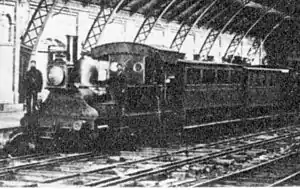1864 in South Africa
The following lists events that happened during 1864 in South Africa.
| |||||||||
| Decades: |
| ||||||||
|---|---|---|---|---|---|---|---|---|---|
| See also: | |||||||||
Incumbents
- Governor of the Cape of Good Hope and High Commissioner for Southern Africa: Sir Philip Wodehouse.
- Lieutenant-governor of the Colony of Natal:
- John Scott (until 30 December).
- John Maclean (from 31 December).
- State President of the Orange Free State:
- Jacobus Johannes Venter (acting until 1 February).[1][2]
- Jan Brand (from 2 February).[1]
- President of the Executive Council of the South African Republic:
- W.C. Janse van Rensburg (until 9 May).[3]
- Marthinus Wessel Pretorius (from 10 May).[3]
Events
- January
- 5 – The Transvaal Civil War ends with Paul Kruger's victory over Jan Viljoen's commando at the Crocodile River.
- February
- 2 – Jan Brand is inaugurated as the fourth president of the Orange Free State.
- May
- 10 – Marthinus Wessel Pretorius, State President of the Orange Free State from 1860 to 1863, is inaugurated as President of the Executive Council of the South African Republic for a second term.[3]
- August
- Bloemhof is founded on the banks of the Vaal River when diamonds are discovered in the area.[4]
- December
- 19 – A railway line to Wynberg, constructed with private capital, is opened to the public.[5]
- 31 – John Maclean becomes Lieutenant-governor of the Colony of Natal.
- Unknown date
- The Republic of New Scotland is set up in Roburnia in what is now the Amsterdam region.
Births
- 2 February - Jan Brand, lawyer and politician, and the fourth state president of the Orange Free State. (d. 1888)
- 6 November - Abraham Bailey, diamond tycoon, politician, financier and cricketer. (d. 1940)
Deaths
- 1 February – David Hume, explorer and big-game hunter. (b. 1796)
- 5 October – John Fairbairn, newspaper proprietor, educator, financier and politician. (b. 1794)
Railways
Railway lines opened
- 19 December – Cape Western – Salt River to Wynberg, 6 miles (9.7 kilometres).[6]
Locomotives
- The first of three 2-4-0 tank locomotives are acquired as motive power for the Wynberg line, one by the Wynberg Railway Company and the other two by the Cape Town Railway and Dock Company who undertakes to rent and operate the line.[7]
References
- Archontology.org: A Guide for Study of Historical Offices, Orange Free State: Heads of State: 1854-1902 (Accessed on 14 April 2017)
- Muller. Oude tyden in den Oranje-Vrystaat. pp. 54, 74, 76, 87, 127, 131, 134, 143, 145, 147, 158, 159, 172, 256.
- Archontology.org: A Guide for Study of Historical Offices, South African Republic (Transvaal): Heads of State: 1857-1877 (Accessed on 14 April 2017)
- Theal, George McCall (1889). History of South Africa: the republics and native territories from 1854 to 1872. London: S. Sonnenschein & co. p. 230.
- Holland, D.F. (1971). Steam Locomotives of the South African Railways. 1: 1859–1910 (1st ed.). Newton Abbott, Devon: David & Charles. pp. 15–17, 23. ISBN 978-0-7153-5382-0.
- Statement Showing, in Chronological Order, the Date of Opening and the Mileage of Each Section of Railway, Statement No. 19, p. 181, ref. no. 200954-13
- Blackie, Article by D. Littley, SA Rail September–October 1989, p. 133.
This article is issued from Wikipedia. The text is licensed under Creative Commons - Attribution - Sharealike. Additional terms may apply for the media files.
